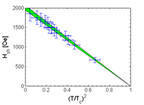CLASSE NEWS | 12 Mar 2010
 Researchers at Cornell have recently made breakthrough measurements of the fundamental properties of the BCS superconductor Niobium, a material commonly used in microwave cavities for superconducting accelerators. Professor Matthias Liepe along with graduate student Nick Valles, has measured Niobium's superheating field in the full temperature range between 1.8K and its critical temperature. The superheating field is the maximum magnetic field up to which the Meissner state of a superconductor can exist as a metastable state. Above the superheating field, the superconductor starts to transition into the normal conducting state.
They found that a simple phenomenological theory accurately (within the
Researchers at Cornell have recently made breakthrough measurements of the fundamental properties of the BCS superconductor Niobium, a material commonly used in microwave cavities for superconducting accelerators. Professor Matthias Liepe along with graduate student Nick Valles, has measured Niobium's superheating field in the full temperature range between 1.8K and its critical temperature. The superheating field is the maximum magnetic field up to which the Meissner state of a superconductor can exist as a metastable state. Above the superheating field, the superconductor starts to transition into the normal conducting state.
They found that a simple phenomenological theory accurately (within the
Temperature dependence of the superheating field in niobium measured

Figure: Plot of the superheating field data versus (T/Tc)2, where the sample's critical temperature was Tc=8.83 K. The green cone shows the Ginzburg-Landau prediction. The cone's width results from measurement uncertainty in a model parameter. The measured data agrees well with the model to within measurement errors..
